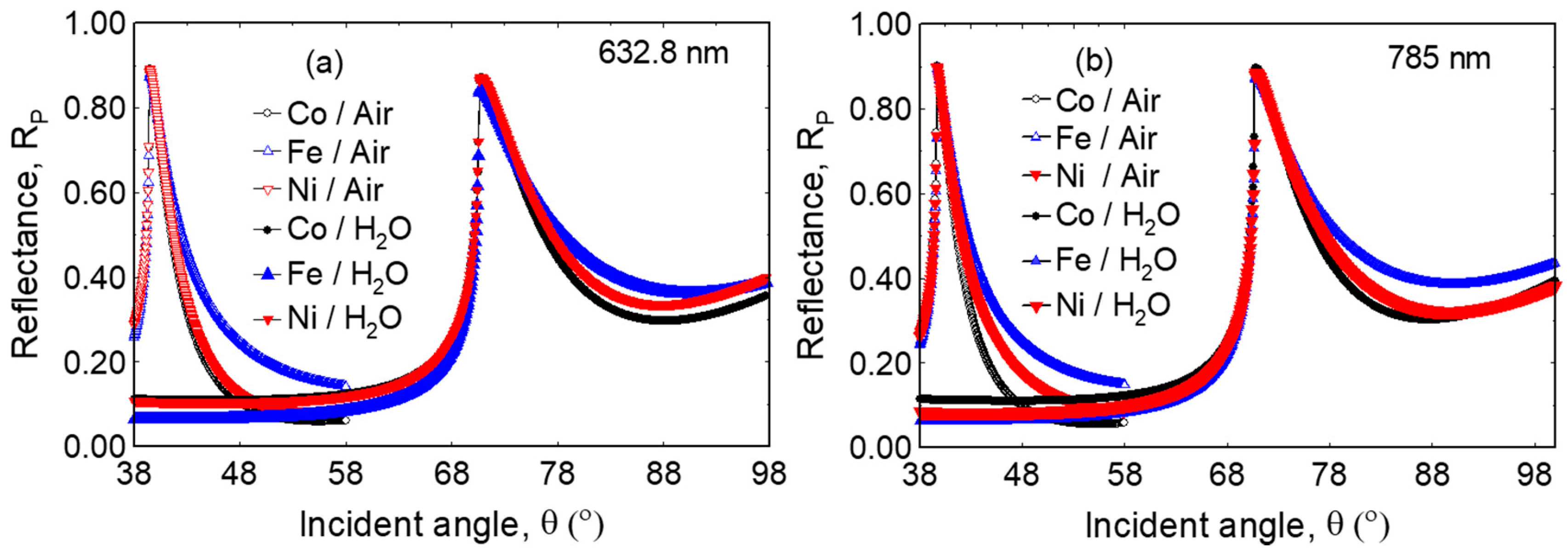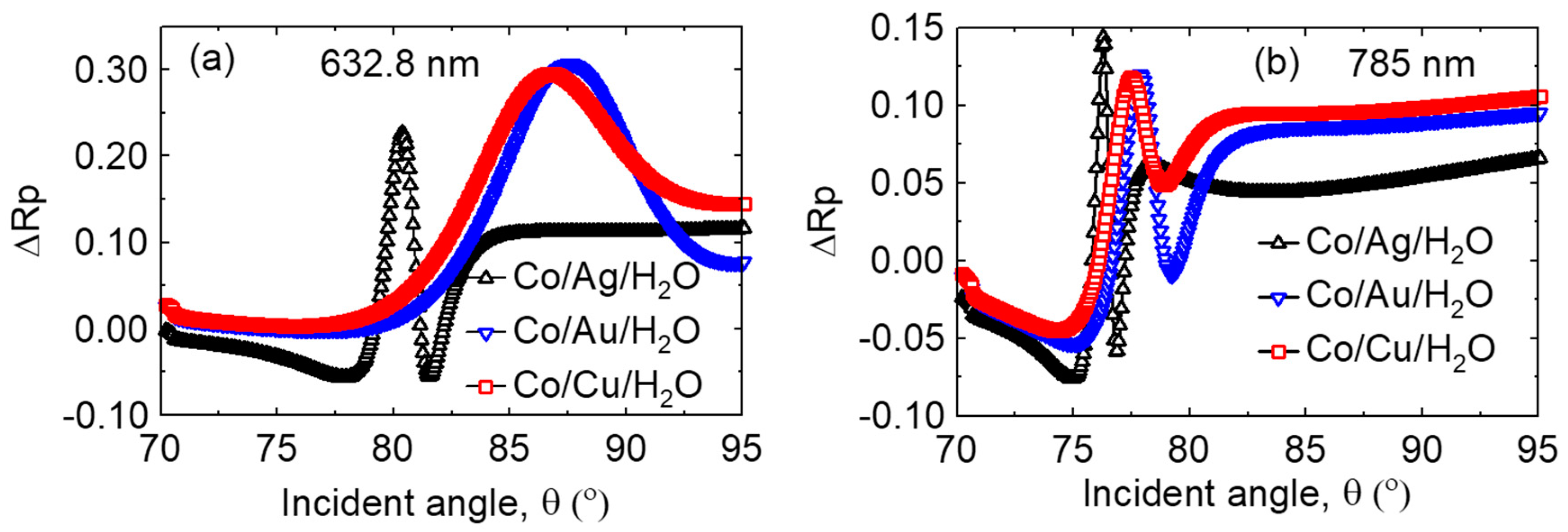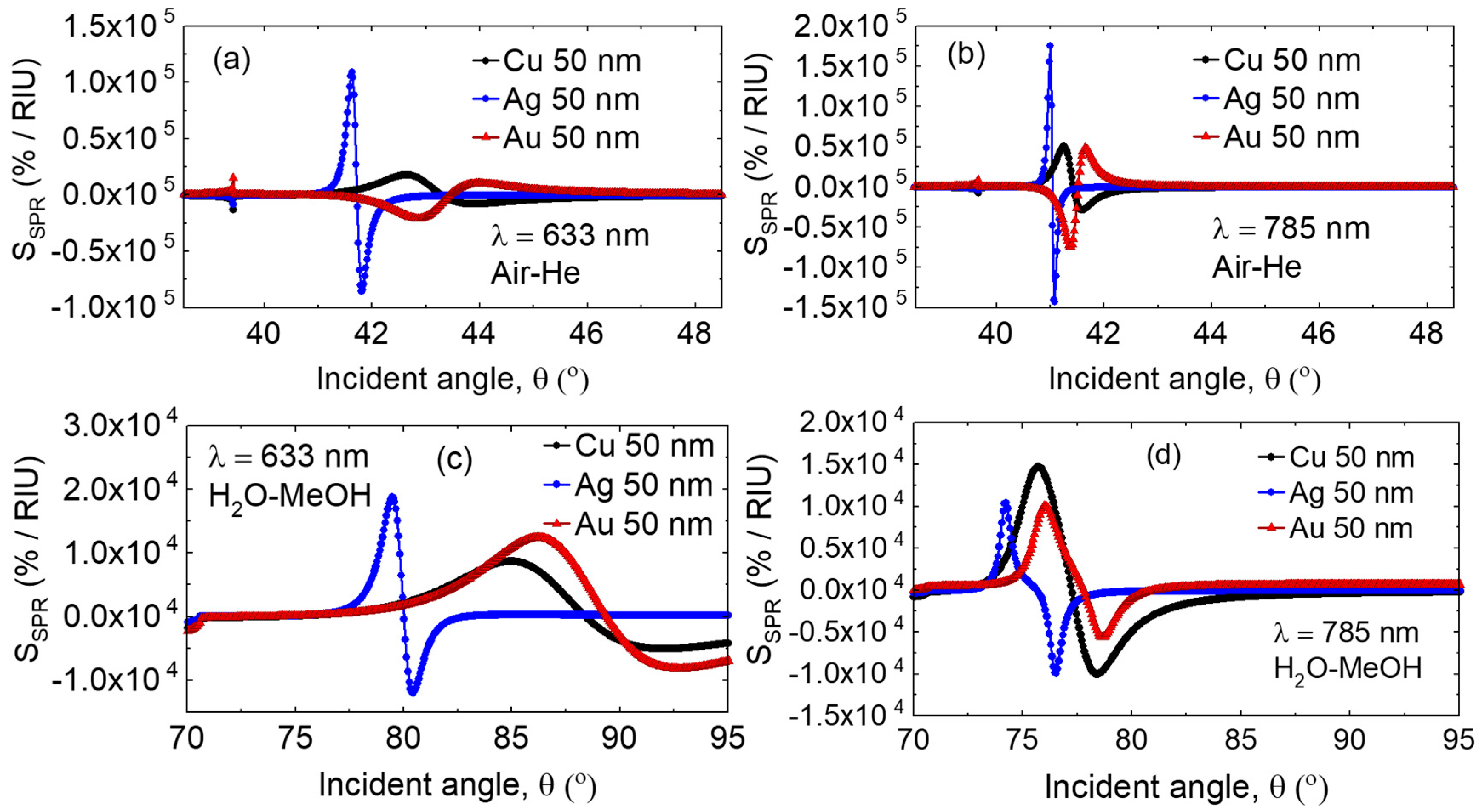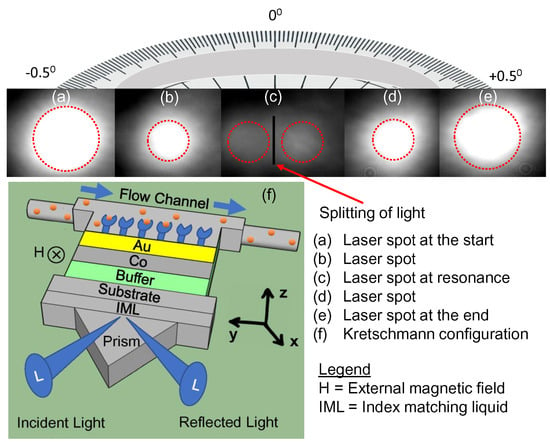Improved Magneto-Optic Surface Plasmon Resonance Biosensors
Abstract
:1. Introduction
2. Materials and Methods
3. SPR and Magneto-Optic SPR Fundamentals
4. Results and Discussion
4.1. SPR Response in Non-Magnetic Layer Configuration (Ag, Au, Cu)
4.2. SPR Response in Magnetic Layer Configuration (Fe, Co, Ni)
4.3. SPR Response in Non-Magnetic/Ferromagnetic Bilayer Configuration
4.4. MO-SPR in Non-Magnetic/Ferromagnetic Bilayer Configuration
4.5. Sensitivity Comparisons for SPR and MO-SPR Configurations
5. Conclusions
Author Contributions
Acknowledgments
Conflicts of Interest
References
- Maier, S.A. Plasmonics: Fundamentals and Applications; Springer Science & Business Media: Berlin/Heidelberg, Germany, 2007. [Google Scholar]
- Nagata, K.; Handa, H. Real-Time Analysis of Biomolecular Interactions (Applications of Biacore); Springer: New York, NY, USA, 2000. [Google Scholar]
- Sharma, A.; Tomar, M.; Gupta, V. Room temperature trace level detection of NO2 gas using SnO2 modified carbon nanotubes based sensor. J. Mater. Chem. 2012, 22, 23608–23616. [Google Scholar] [CrossRef]
- Huang, Q.; Zeng, D.; Li, H.; Xie, C. Room temperature formaldehyde sensors with enhanced performance, fast response and recovery based on zinc oxide quantum dots/graphene nanocomposites. Nanoscale 2012, 4, 5651–5658. [Google Scholar] [CrossRef] [PubMed]
- Kretschmann, E. The angular dependence and the polarisation of light emitted by surface plasmons on metals due to roughness. Opt. Commun. 1972, 5, 331–336. [Google Scholar] [CrossRef]
- Otto, A. Excitation of nonradiative surface plasma waves in silver by the method of frustrated total reflection. Z. Phys. A Hadrons Nucl. 1968, 216, 398–410. [Google Scholar] [CrossRef]
- Dakss, M.; Kuhn, L.; Heidrich, P.; Scott, B. Grating coupler for efficient excitation of optical guided waves in thin films. Appl. Phys. Lett. 1970, 16, 523–525. [Google Scholar] [CrossRef]
- Rizal, C.; Niraula, B.; Lee, H. Bio-Magnetoplasmonics, Emerging Biomedical Technologies and Beyond. J. Nanomed. Res. 2016, 3, 00059. [Google Scholar] [CrossRef]
- Bonanni, V.; Bonetti, S.; Pakizeh, T.; Pirzadeh, Z.; Chen, J.; Noguis, J.; Vavassori, P.; Hillenbrand, R.; Ãkerman, J.; Dmitriev, A. Designer magnetoplasmonics with nickel nanoferromagnets. Nano Lett. 2011, 11, 5333–5338. [Google Scholar] [CrossRef] [PubMed]
- Brolo, A.G. Plasmonics for future biosensors. Nat. Photonics 2012, 6, 709–713. [Google Scholar] [CrossRef]
- Armelles, G.; Cebollada, A.; Garcia-Martan, A.; Gonzalez, M.U. Magnetoplasmonics: Combining Magnetic and Plasmonic Functionalities. Adv. Opt. Mater. 2013, 1, 2–21. [Google Scholar] [CrossRef]
- Ignatyeva, D.O.; Knyazev, G.A.; Kapralov, P.O.; Dietler, G.; Sekatskii, S.K.; Belotelov, V.I. Magneto-optical plasmonic heterostructure with ultranarrow resonance for sensing applications. Sci. Rep. 2016, 6, 28077. [Google Scholar] [CrossRef] [PubMed]
- Jain, P.K.; Xiao, Y.; Walsworth, R.; Cohen, A.E. Surface plasmon resonance enhanced magneto-optics (SuPREMO): Faraday rotation enhancement in gold-coated iron oxide nanocrystals. Nano Lett. 2009, 9, 1644–1650. [Google Scholar] [CrossRef] [PubMed]
- Lodewijks, K.; Maccaferri, N.; Pakizeh, T.; Dumas, R.K.; Zubritskaya, I.; Ãkerman, J.; Vavassori, P.; Dmitriev, A. Magnetoplasmonic design rules for active magneto-optics. Nano Lett. 2014, 14, 7207–7214. [Google Scholar] [CrossRef] [PubMed]
- Manera, M.G.; Ferreiro-Vila, E.A.; Garcia-Martin, J.M.; Garcia-Martin, A.; Rella, R. Enhanced antibody recognition with a magneto-optic surface plasmon resonance (MO-SPR) sensor. Biosens. Bioelectron. 2014, 58, 114–120. [Google Scholar] [CrossRef] [PubMed] [Green Version]
- Newman, D.M.; Wears, M.L.; Matelon, R.J.; Hooper, I.R. Magneto-optic behaviour in the presence of surface plasmons. J. Phys. Condens. Matter 2008, 20, 345230. [Google Scholar] [CrossRef] [Green Version]
- Papaioannou, E.T.; Karoutsos, V.; Angelakeris, M.; Valassiades, O.; Fumagalli, P.; Flevaris, N.K.; Poulopoulos, P. Magnetic, magneto-optic and magnetotransport properties of nanocrystalline Co/Au multilayers with ultrathin Au interlayers. J. Nanosci. Nanotechnol. 2008, 8, 4323–4327. [Google Scholar] [CrossRef] [PubMed]
- Schubert, M.; Tiwald, T.E.; Woollam, J.A. Explicit solutions for the optical properties of arbitrary magneto-optic materials in generalized ellipsometry. Appl. Opt. 1999, 38, 177–187. [Google Scholar] [CrossRef] [PubMed]
- Sepúlveda, B.; Calle, A.; Lechuga, L.M.; Armelles, G. Highly sensitive detection of biomolecules with the magneto-optic surface-plasmon-resonance sensor. Opt. Lett. 2006, 31, 1085–1087. [Google Scholar] [CrossRef] [PubMed]
- Zvezdin, A.K.; Kotov, V.A. Modern Magnetooptics and Magnetooptical Materials; CRC Press: Boca Raton, FL, USA, 1997. [Google Scholar]
- Regatos, D.; Sepúlveda, B.; Fariña, D.; Carrascosa, L.G.; Lechuga, L.M. Suitable combination of noble/ferromagnetic metal multilayers for enhanced magneto-plasmonic biosensing. Opt. Express 2011, 19, 8336–8346. [Google Scholar] [CrossRef] [PubMed]
- Rizal, C.; Pisana, S.; Hrvoic, I.; Fullerton, E. Microstructure and magneto-optical surface plasmon resonance of Co/Au multilayers. J. Phys. Commun. 2018, 2, 055010. [Google Scholar] [CrossRef] [Green Version]
- Piliarik, M.; Homola, J. Surface plasmon resonance (SPR) sensors: Approaching their limits? Opt. Express 2009, 17, 16505–16517. [Google Scholar] [CrossRef] [PubMed]
- Wang, T.-J.; Lee, K.-H.; Chen, T.-T. Sensitivity enhancement of magneto-optic surface plasmon resonance sensors with noble/ferromagnetic metal heterostructure. Laser Phys. 2014, 24, 036001. [Google Scholar] [CrossRef]
- D’Amico, A.; Di Natale, C. A contribution on some basic definitions of sensors properties. IEEE Sens. J. 2001, 1, 183–190. [Google Scholar] [CrossRef]
- Schasfoort, R.B.M.; Tudos, A.J. Handbook of Surface Plasmon Resonance; Royal Society of Chemistry: London, UK, 2008. [Google Scholar]
- Maksymov, I.S. Magneto-plasmonics and resonant interaction of light with dynamic magnetisation in metallic and all-magneto-dielectric nanostructures. Nanomaterials 2015, 5, 577–613. [Google Scholar] [CrossRef] [PubMed]
- Temnov, V.V. Ultrafast acousto-magneto-plasmonics. Nat. Photonics 2012, 6, 728–736. [Google Scholar] [CrossRef] [Green Version]
- Vila, E.-F.; Bendana Sueiro, X.M.; Gonzalez-Diaz, J.B.; Garcia-Martin, A.; Garcia-Martin, J.M.; Cebollada Navarro, A.; Armelles Reig, G.; Meneses Rodriguez, D.; Sandoval, E.M. Surface plasmon resonance effects in the magneto-optical activity of Ag/Co/Ag trilayers. IEEE Trans. Magn. 2008, 44, 3303–3306. [Google Scholar] [CrossRef] [Green Version]
- Rizal, C.; Fullerton, E. Perpendicular magnetic anisotropy and microstructure properties of nanoscale Co/Au multilayers. J. Phys. D Appl. Phys. 2017, 50, 355002. [Google Scholar] [CrossRef]
- González-Díaz, J.; Sepúlveda, B.; García-Martín, A.; Armelles, G. Cobalt dependence of the magneto-optical response in magnetoplasmonic nanodisks. Appl. Phys. Lett. 2010, 97, 043114. [Google Scholar] [CrossRef] [Green Version]
- Pellegrini, G.; Mattei, G. High-performance magneto-optic surface plasmon resonance sensor design: An optimization approach. Plasmonics 2014, 9, 1457–1462. [Google Scholar] [CrossRef]
- Robertson, W.M.; Fullerton, E. Reexamination of the surface-plasma-wave technique for determining the dielectric constant and thickness of metal films. J. Opt. Soc. Am. B 1989, 6, 1584–1589. [Google Scholar] [CrossRef]












| Material | Thickness t (nm) | Permittivity, ε; εmo at λ = 632.8 nm | Permittivity, ε; εmo at λ = 785 nm |
|---|---|---|---|
| Substrate/BK-7 | 1.3 mm | 2.2940 | 2.2813 |
| BK-7 Prism | - | 2.2940 | 2.2813 |
| Index match Liquid | - | 2.2940 | 2.2813 |
| Au | 35/50 | −11.127 + j1.3268 | −22.855 + j1.4245 |
| Ag | 35/50 | −18.228 + j0.48198 | −29.789 + j0.37611 |
| Cu | 35/50 | −11.560 + j1.8393 | −23.893 + j2.4365 |
| Co | 4/8 | −12.475 + j18.451; −0.65 + j0.0005 | −16.493 + j23.377; −0.85 + j0.0006 |
| Fe | 8 | −1.0366 + j17.771 | −2.0612 + j21.601 |
| Ni | 8 | −12.944 + j16.363 | −6.5092 + j24.811 |
| Ta | 2 | −31.101 + 12.005 | −50.104 + j14.240 |
| He | - | 1.0000698 | 1.0000696 |
| Air | - | 1.000553 | 1.0005502 |
| Methanol | - | 1.759 | 1.7296 |
| Water | - | 1.7734 | 1.7678 |
| Material | SPR Sensitivity (632.8 nm) | MO-SPR Sensitivity (632.8 nm) | SPR Sensitivity (785 nm) | MOSPR Sensitivity (785 nm) |
|---|---|---|---|---|
| Cu(50) | 2.0 × 104 | - | 5.0 × 104 | - |
| Ag(50) | 1.1 × 105 | - | 1.8 × 105 | - |
| Au(50) | 2.5 × 104 | - | 7.5 × 104 | - |
| Co(8)/Ag(35) | 5.2 × 104 | 8.0 × 104 | 3.3 × 105 | 8.0 × 105 |
| Co(8)/Au(35) | 1.6 × 104 | 4.0 × 104 | 2.1 × 105 | 2.2 × 105 |
| Co(4)/Ag(35) | - | - | - | 2.5 × 106 |
| Co(4)/Au(35) | - | - | - | 5.7 × 105 |
| Material | SPR Sensitivity (632.8 nm) | MOSPR Sensitivty (632.8 nm) | SPR Sensitivity (785 nm) | MOSPR Sensitivty (785 nm) |
|---|---|---|---|---|
| Cu(50) | 7.0 × 103 | - | 1.5 × 104 | - |
| Ag(50) | 1.9 × 104 | - | 1.1 × 104 | - |
| Au(50) | 1.3 × 104 | - | 1.1 × 104 | - |
| Co(8)/Ag(35) | 1.9 × 104 | 5.6 × 104 | 9.0 × 103 | 5.7 × 104 |
| Co(8)/Au(35) | 8.0 × 103 | 3.7 × 104 | 1.3 × 104 | 9.0 × 104 |
© 2018 by the authors. Licensee MDPI, Basel, Switzerland. This article is an open access article distributed under the terms and conditions of the Creative Commons Attribution (CC BY) license (http://creativecommons.org/licenses/by/4.0/).
Share and Cite
Rizal, C.; Pisana, S.; Hrvoic, I. Improved Magneto-Optic Surface Plasmon Resonance Biosensors. Photonics 2018, 5, 15. https://doi.org/10.3390/photonics5030015
Rizal C, Pisana S, Hrvoic I. Improved Magneto-Optic Surface Plasmon Resonance Biosensors. Photonics. 2018; 5(3):15. https://doi.org/10.3390/photonics5030015
Chicago/Turabian StyleRizal, Conrad, Simone Pisana, and Ivan Hrvoic. 2018. "Improved Magneto-Optic Surface Plasmon Resonance Biosensors" Photonics 5, no. 3: 15. https://doi.org/10.3390/photonics5030015






